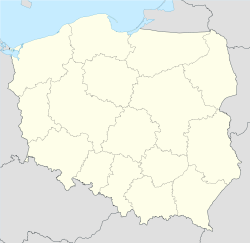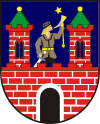Kalisz
| Kalisz | |||
|
|
|||
|
|||
| Motto: Poloniae urbs vetustissima | |||
 Kalisz
|
|||
| Coordinates: | |||
| Country | |||
|---|---|---|---|
| Voivodeship | Greater Poland | ||
| County | city county | ||
| Established | 2nd century | ||
| Town rights | after 1253 | ||
| Government | |||
| - Mayor | Janusz Pęcherz | ||
| Area | |||
| - City | 70 km² (27 sq mi) | ||
| Population (2007) | |||
| - City | 108,841 | ||
| - Density | 1,554.9/km² (4,027.1/sq mi) | ||
| - Metro | 357,349 | ||
| Time zone | CET (UTC+1) | ||
| - Summer (DST) | CEST (UTC+2) | ||
| Postal code | 62-800 to 62-821 | ||
| Area code(s) | +48 062 | ||
| Car plates | PK | ||
| Website: http://www.kalisz.pl | |||




Kalisz [ˈkalʲiʂ] (![]() listen) is a city in central Poland with 109,800 inhabitants (1995). Situated on the Prosna river in the southeastern part of the Greater Poland Voivodeship, the city forms a conurbation with the nearby towns of Ostrów Wielkopolski and Skalmierzyce. See Kalisz County for the regional administrative area (powiat).
listen) is a city in central Poland with 109,800 inhabitants (1995). Situated on the Prosna river in the southeastern part of the Greater Poland Voivodeship, the city forms a conurbation with the nearby towns of Ostrów Wielkopolski and Skalmierzyce. See Kalisz County for the regional administrative area (powiat).
Kalisz is an important regional industrial and commercial centre, with many notable factories, the Calisia piano factory among them. The city is also a centre for traditional folk art.
Contents |
History
Kalisz is now considered to be the oldest town of Poland, because it was mentioned by Ptolemy as Calisia. That town was situated in the territory of the Diduni (Vandals) in Magna Germania on the Amber Trail. Although it is still not certain whether the exact spot where the city centre is located nowadays was inhabited in 2nd century, there are many artifacts of the Roman times in the area, pointing to the fact that it must have been one of the stops of the Roman caravans heading for the Baltic Sea.
Modern Kalisz was most probably founded in 9th century as a castellany and a minor fort. The name itself stems from the Celtic term cal which means stream, or Slavic term kal, meaning swamp or marsh. In 1106 Bolesław Krzywousty captured the town and incorporated it into his feudal domain. Between 1253 and 1260 the town was granted German town law called Środa Śląska Law after Środa Śląska in Silesia, a local variation of the Magdeburg Law, and soon started to grow. One of the richest towns of Greater Poland, during the feudal fragmentation of Poland it formed a separate duchy ruled by local branch of the Piast dynasty. After Poland was reunited, the town became a notable centre of weavery and wood production, as well as one of the cultural centres of Greater Poland. The economical development of the area was aided by a large number of Protestant Czech Brothers, who settled in and around Kalisz after being expelled from Bohemia. Also, Jewish settlement of Kalisz dates back to 1139.
In 1282 the city laws were confirmed by Przemysł II of Poland and in 1314 it was made the capital of the Kalisz Land, one of the Voivodeships of Poland, by king Władysław Łokietek. A notable centre of trade, Kalisz was also located more or less in the centre of Poland back then. Because of its strategic location, in 1343 king Casimir III signed there a peace treaty with the Teutonic Order. As a royal town, the city managed to defend much of its initial privileges and in 1426 a new town hall was built. Also, it was there that king Mieszko the Old is buried.
In 1574 the Jesuits were brought to Kalisz and in 1584 they opened a Jesuit College there, one of the most notable centres of education in Poland back then. However, with time the importance of Kalisz declined and its place was taken by nearby Poznań.
In 1792, fire destroyed much of the city centre. The following year, in the second partition of Poland, the Kingdom of Prussia absorbed the city, called "Kalisch" in German. In 1801, Wojciech Bogusławski there built one of the first permanent theatres in the region.
In 1806 Kalisz was joined with the Duchy of Warsaw. During Napoleon's invasion of Russia, following Yorck's Convention of Tauroggen of 1812, von Stein's Treaty of Kalisz was signed between Russia and Prussia in 1813, confirming that Prussia now was on the side of the Allies.
After the defeat of Napoleon Bonaparte, Russia annexed Kalisz. The nearness of the Prussian border accelerated economic development of the city and Kalisz ("Кализ" in the Russian Cyrillic alphabet) started to attract many settlers, not only from other regions of Poland and other provinces of the Russian empire but also from German states. In 1902, a new railroad linked Kalisz to Warsaw and Łódź.
After the outbreak of the Great War, the proximity of the border proved disastrous for the city, as it was one of the first destroyed towns of that war. After a series of border clashes, the German army bombed the city with artillery. During the heavy fights that lasted from August 7 to August 22, 1914, the town was destroyed almost completely (see destruction of Kalisz) after entry of the German units led by Hermann Preusker. 800 men were arrested and then several of them slaughtered, while the city was set on fire and the remaining inhabitants were expelled. Out of roughly 68,000 inhabitants in 1914, only 5,000 live in the city the following year. However, by the end of the Great War much of the city centre was more or less rebuilt and many of the former inhabitants were allowed to return to their town.
After the war Kalisz became part of the, once again independent, Republic of Poland. The reconstruction continued and in 1925 the new town hall was opened. Until 1939 the town had roughly 89,000 inhabitants. After the outbreak of the Invasion of Poland (1939),World War II, the proximity of the border proved once again disastrous. Although the town was captured by the Wehrmacht almost instantly and without much fight, the city was directly annexed by Nazi Germany. By the end of World War II approximately 30,000 local Jews had been murdered. Additional 20,000 local Catholics were either murdered or expelled to the General Government or to Germany as slave workers. In 1945 the city had only 43,000 inhabitants, that is roughly half of the pre-war population.
After World War II the reconstruction of the town started. In 1975, after Edward Gierek's reform of the administrative scheme of Poland, Kalisz became the seat of a separate Kalisz Voivodeship. It was abolished in 1998 and since then Kalisz has been the capital of a separate powiat within the Greater Poland Voivodeship. In 1991 the city's feast was established on June 11, to commemorate the reaffirmation of city rights in 1282. The following year the city became a seat of a separate diocese.
Education
Kalisz is a notable centre of education in the region. It is home to 30 kindergartens, 29 primary schools, and fifteen junior high schools. Seven colleges and a dozen or so trade schools are located there. The city is also home to branches of Poznań University, Poznań University of Economy, and Poznań University of Science and Technology, as well as several other institutions of higher education.
Economy
Although there is little heavy industry within the city limits, Kalisz is home to several of the biggest companies in Poland. It is notable for the Calisia piano factory and for the Winiary and Ziołopex food processing plants (the former is now part of the Nestlé group), the Big Star jeans factory, and the Hellena, Jutrzenka, and Kaliszanka soft-drink production plants. Two plane engines production factories, WSK-Kalisz and Pratt & Whitney Kalisz (a branch of Pratt & Whitney Canada), are located in Kalisz.
Sports
- Winiary Kalisz - women's volleyball team playing in Polish Seria A Women's Volleyball League:Champions of Poland,2nd place in 2003/2004 season and 1st place in 2004/2005 season. - *www.calisiassk.pl
- KKS 1925 Kalisz - men's soccer team playing in Polish B-Class Soccer League. - *www.kkskalisz.pl
Notable people from Kalisz
- Avraham Gombiner 1633 Jewish rabbi and scholar
- Wojciech Bogusławski 1757 playwright and director playwright
- Cyprian Godebski 1765 freedom fighter and a poet
- Dawid Flamm 1793 gynecologist
- Karl Heinrich Hermes 1800-1856 journalist
- Thekla von Gunkert 1810 author
- Agaton Giller - (*1831 in Opatówek, Poland - +1887 in Stanisławów) - patriotic activist
- Stefan Giller - (*1833 in Opatowek, Poland - +1918) - poet, an epigone of the Polish Romanticism
- Adam Asnyk 1838 poet
- Ludwig Adolf Neugebauer 1856 gynecologist
- Juliusz Bursche 1862 bishop
- Jerzy Świrski 1882 - Vice-Admiral
- Maria Dąbrowska 1889 writer
- Theodor Meron 1930 president of the (ICTY) and judge in the International Criminal Tribunal for Rwanda
- Stanisław Barcikowski, painter
- Boleslaus the Pious, duke of Greater Poland
- Bolesław III Rozrzutny, duke of Silesia
- Izabela Cywińska, director
- Augustyn Kordecki, prior of the Jasna Góra Monastery and hero of The Deluge
- Yehiel Krize,painter
- Jerzy Kryszak, actor
- Tadeusz Kulisiewicz, artist
- Bonawentura Niemojowski, journalist
- Wincenty Niemojowski, journalist
- Alfons Parczewski, lawyer, rector of the Wilno University
- Wlasyslaw Pilars de Pilar - poet
- Wojciech Siemion, actor and director
- Zevi Herman Solnik, writer and Zionist
- Zdzisława Sośnicka, singer
- Stefan Szolc-Rogoziński, traveller and explorer
- Stanisław Wojciechowski, president of Poland
- Mieczysław Voigt, actor
- Alfred Wierusz-Kowalski, painter
- Jan Ptaszyn Wróblewski, musician
- Kris Grzymski, archaeologist
- Artur Zawisza Czarny, freedom fighter
- Zvi Hirsch Chajes, 19th c. Talmudic scholar
- Janina Davidska, 20th c Author
- Mania Zolta, 20th c Bubba
- Diana Błaszczyk, 21st c. Go Player
- Iga Wyrwal, model
Twin Towns - Sister Cities
Kalisz is twinned with:[1]
|
References
- ↑ "Kalisz Official Website - Twin Towns".

 (in English and Polish) © 2005-2008 Urząd Miejski Kalisz. Retrieved on 2008-11-29.
(in English and Polish) © 2005-2008 Urząd Miejski Kalisz. Retrieved on 2008-11-29.
See also
- History of the Jews in Kalisz
- Kalisz Department (Polish: Departament Kaliski): a unit of administrative division and local government in Polish Duchy of Warsaw in years 1806-1815.
- Kaliszanie
|
||||||||||
|
|||||||



